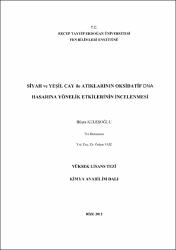| dc.description.abstract | Serbest radikal hasarının ateroskleroz, kanser, yaşlanma gibi pek çok dejeneratif hastalığın gelişmesinde katkısı olduğu bilinmektedir. Son yıllarda antioksidan amaçla fenolik fitokimyasalların ve bitkisel ürünlerin kullanımı artmaktadır. Ancak bitkisel ürünler prooksidan ve antioksidan olarak ikili etkide bulunabilirler. Yeşil ve siyah çayın reaktif oksijen bileşiklerinin zararlı etkilerine karşı organizmayı koruduğuna dair pek çok çalışma olmasına rağmen bu çaylara ait atıkların etkisine yönelik yeterli çalışma yapılmamıştır. Bu çalışmanın amacı, siyah ve yeşil çay ile bunların farklı atıklarından elde edilen özütlerin fenolik içeriğini belirlemek ve onların insan lenfositlerinde hidrojen peroksit tarafından indüklenen oksidatif DNA hasarına karşı koruyucu etkilerini tek hücre jel elektroforez (comet) yöntemiyle karşılaştırmaktır. Çalışmada kullanılan numuneler Rize'de bulunan çay fabrikalarından sağlanmıştır. Çay ve atık ekstraktlarının toplam fenolik madde içerikleri Folin-Ciocalteau reaktifi ile kateşin standartına eşdeğer olarak belirlenmiştir ve fenolik içerikleri (K, EK, EGK, EGKG, EGK and gallik asit) HPLC-PAD sistemi ile tespit edilmiştir. DPPH radikal temizleme aktivitesi Cuendet metodu ile eşdeğer kateşin standartıyla karşılaştırılmalı olarak tayin edilmiştir. DNA hasarı Comet assay yöntemi ile tespit edilmiştir. Özütlerde en yüksek fenolik bileşim, radikal temizleme etkisi ve anti-DNA hasar aktivitesi yeşil çayda gözlemlenmiştir (1 µM konsantrasyona sahip ekstraktlarda sırasıyla, 68 ?????? mg/g, 10 ????? µM ?? 0,49±0,06 ?? ). Tüm özüt ekstraktlarında fenolik içerik sıralamasının: YÇ > YÇYA > SÇ = YÇGA > SÇLA, DPPH aktivite sıralamasının: YÇ > YÇYA > SÇ = YÇGA > SÇLA ve anti-DNA hasar aktivite sıralamasının: YÇ ?SÇ ?YÇYA ? YÇGA ? SÇLA olduğu tespit edilmiştir. Deney ortamında fenolik içeriğin artırılması sonucunda ise çay ve atıklarının prooksidan etki göstermeye başladığı belirlenmiştir. Sonuç olarak, DNA hasarına yönelik koruyuculuğu bakımından çay atıklarının da çayın kendisi kadar etkili olduğu ve değerlendirilerek ekonomik bir katkı sağlayabileceği belirlenmiştir.Anahtar kelimeler: Çay, Çay Atıkları, DPPH, Comet Free radical damage is known for contributing atherosclerosis, cancer, aging and many other degenerative diseases. Moreover, the last few years have illustrated the increase of using antioxidant phenpolic phytpchemicals and plant products. However, herbal producst could have a bimodal effect such as prooaxidant and antioxidant. Many researches show that green and black teas have antioxidant substance, but there is no study enough to show the effect of wastes on cellulare systems. The aim of this research is to determine phenolic composition and compare the ability of extracts of black, green teas and their wastes extracts to prevent oxidative DNA damage on hydrogen peroxide-induced human lymphocytes by the single cell gel electrophoresis method (Comet assay). The tea and waste samples in present study was provided by two tea factories in Rize, Turkey. Total phenolic contents of all extracts of tea samples were evaluated with Folin- Ciocalteau reagent as catechin equivalent and the phenolic constituents (C, EC, EGC, EGCG, EGC and gallic acid) were determined by HPLC-PAD system. DPPH radical scavenging activities of the extracts were measured by the Cuendet method comparing with catechin standard. DNA damage was measured by Comet assay. The highest total phenolic content, radical scavenging activity and anti-DNA damage activity were observed in the green tea extract (68 ??????? mg/g, 10 ?????? µM ?? 0,49 ±0,06 ? for 1 µM extract concentration, respectively). The findings for all of sample extract as follow: YÇ > YÇYA > SÇ = YÇGA > SÇLA for phenolic content, YÇ > YÇYA > SÇ = YÇGA > SÇLA for DPPH activity and YÇ ?SÇ ?YÇYA ? YÇGA ? SÇLA for anti-DNA damage activity. Wastes of black and green tea as well as theirself teas may reduce oxidative DNA damage. That leaf waste of green tea may improve DNA fracmentation as does black tea is an intriguing finding. When phenolic content added into the experimental media was increased, tea and its wastes began to show prooxidant effect, another notworthy data obtained in this study. As a result, tea waste as tea has protective effect on DNA damage, which may encourage to entrepreneurs that can make an economic value.Key Words: Tea, Tea Wastes, DPPH, Cometassay | en_US |


















